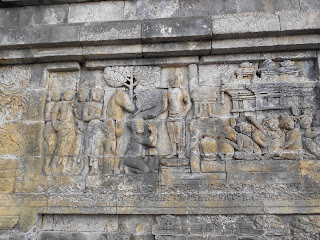Borobudur - Buddhist Heaven
(More photos on Borobudur later in this page)
Built by the Sailendra dynasty in central Java over a period of 80 years in the 9th century AD, Borobudur was "built to resemble a microcosm of the universe and its purpose was to provide a visual image of the teachings of the Buddha and show, in a practical manner, the steps through life that each person must follow to achieve enlightenment. The pilgrim to this shrine would first have been led around the base and shown the friezes, which illustrate the consequences of living in the World of Desire. In this realm ruled by Greed, Envy, and Ignorance, man is a slave to earthly desires and suffers from the illusions that are caused by these unfulfilled yearnings, a state regarded as hell by Buddhists. After completing this circuit, the pilgrim was then led in a clockwise fashion through five levels in a gradual ascension of the pyramid. Here he was shown how to conquer desire and attachment by viewing 1300 panelled friezes that illustrate the life of the Buddha and his previous incarnations. These levels were called the World of Form and correspond to the earthly realm in Buddhist symbology. The passages of both of these realms followed the square shape of the pyramid but above these two lay the World of Formlessness where the right-angled, heavily decorated passages gave way to a round unadorned summit where meditating Buddhas and saints sit in supreme bliss contemplating a view of exquisite beauty. In the centre a bell shaped tower, or stupa, points to heaven, a blissful realm beyond form and concept, known as Nirvana." Tim Alderson, http://www.buddhanet.net/e-learning/history/buddhist-art/boro.htm

It was my third visit to Borobudur.
.jpg) |
| Art, religion and politics-Maitreya as Chakravartin |
 | ||||||||||||||||||
| Carvings at the base of Borobudur |
 |
| Cosmic Buddhas of the Ten Directions (Buddha Dasadiga) |
.jpg) |
| Sudhana and Maitreya |
.jpg) |
| Sudhana Near Maitreya's Kutagara |
"The Gandavyūha, a sacred text of Mahāyāna Buddhism, is an allegorical tale of the pilgrimage of a youth named Sudhana, who visits fifty-three spiritual mentors to receive their instruction in the Conduct of the Bodhisattva. His miraculous journey on the path towards Enlightenment inspired the sculptors of Borobudur (9th century C.E.) to illustrate the tale in 460 bas-reliefs on the higher galleries of this greatgreatJavanese monument." http://www.worldcat.org/title/entering-the-dharmadhatu-a-study-of-the-gandavyuha-reliefs-of-borobudur/oclc/761196080
Sources:
Buddhist Practice and Visual Culture : The Visual Rhetoric of Borobudur. by Julie Gifford (Routledge 2011)
.jpg) | |||||
Symbol of Chakravartin
|

Accompany Surin Pitsuwan (ASEAN Secy-Gen) to Borobudur again, but on the way, we stop at a river where the lava from the last Merapi eruption can be seen vividly. We collect lava stones and take photos.Next stop is a Pondok (Islamic boarding school). To my utter surprise, one of the two people receiving us, recognizes my name. when Surin introduces me as Amitav, he says, are you Amitav Acharya, the professor? Our puzzle in answered when he reveals that he was also a professor in Jakarta and a members of the Indonesian Human Rights groups who set up a Center for Human Security. He wrote to me for an article on human security to be translated into Indonesian, because my writings gave an Asian perspective, where as most available writings on the subject gave western perspectives. I now remembered. Instead of writing s new article, I send him some existing writings of mine and asked him to translate these.
We then go to Borobudur again, just in time to see the sunset. And then back to Jogja. On the way, stop at local roadside crafts shops, where I pick up a Ganesha for 300,000 rupiah, made from stone from the Merapi eruption.
12th July: After my presentation to the conference, I take off to Solo, renting a taxi for the half day. But just too late to see the inside of the Kraton, Solo’s main attraction, Instead take a rickshaw ride around the palace and take pictures of the very interesting buildings, bith inside and outside the palace compound.
Returning to Jogja, we passed by just in time to see the Prambanan temples at dusk. What a marvelous sight! Standing from where they hold the Ramayana Ballet in summer, you get a holistic view of the complex, quite a different perspective of the complex than actually what you get from inside the complex, which I had visited in 2005. You get a sense of how large the complex is, a worthy rival to Borobudur itself (the Sanjayas who built it might have thought so, to rival Shailendra-built Borobudur)

.jpg)

.jpg)






































.jpg)

.jpg)



.jpg)









No comments:
Post a Comment